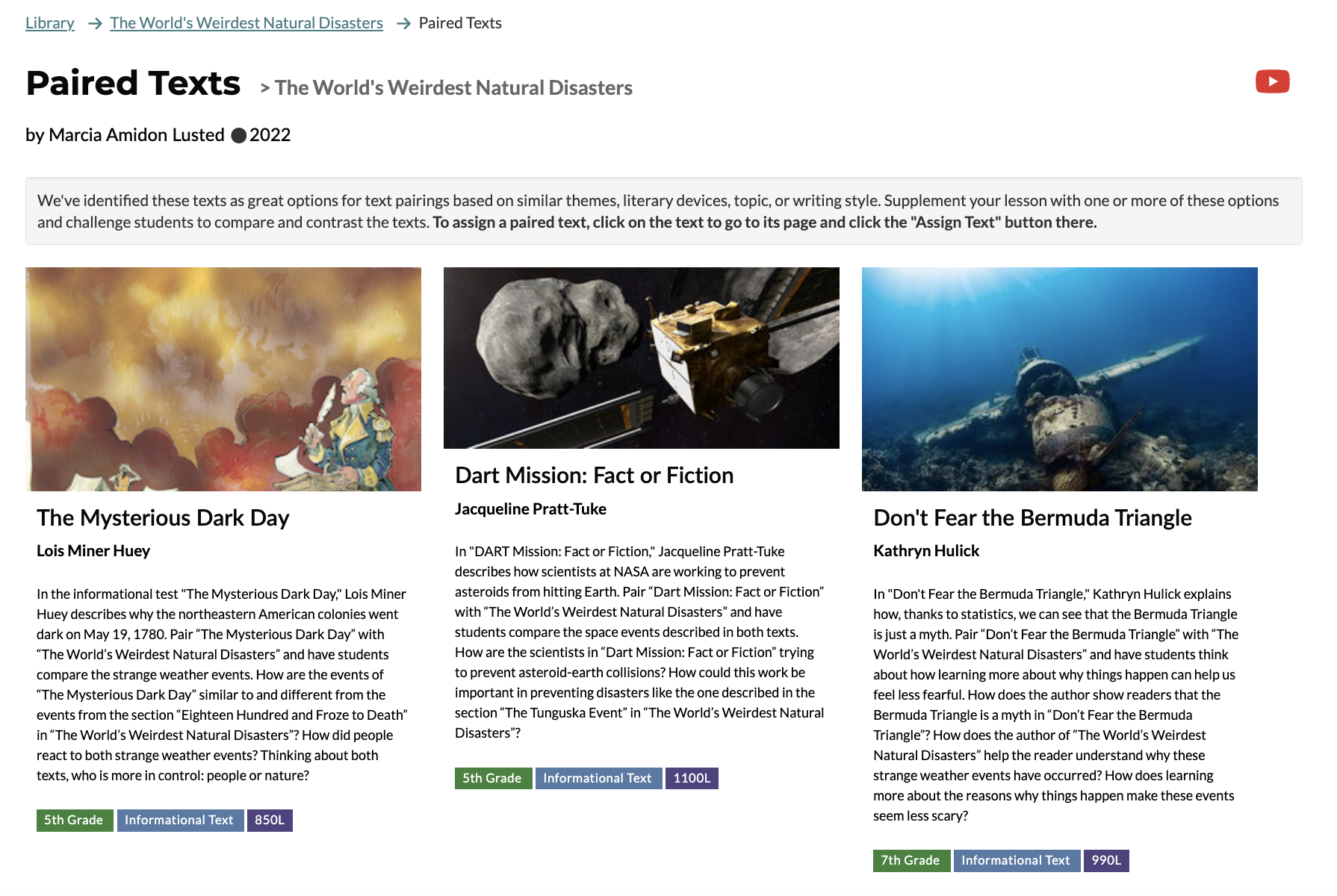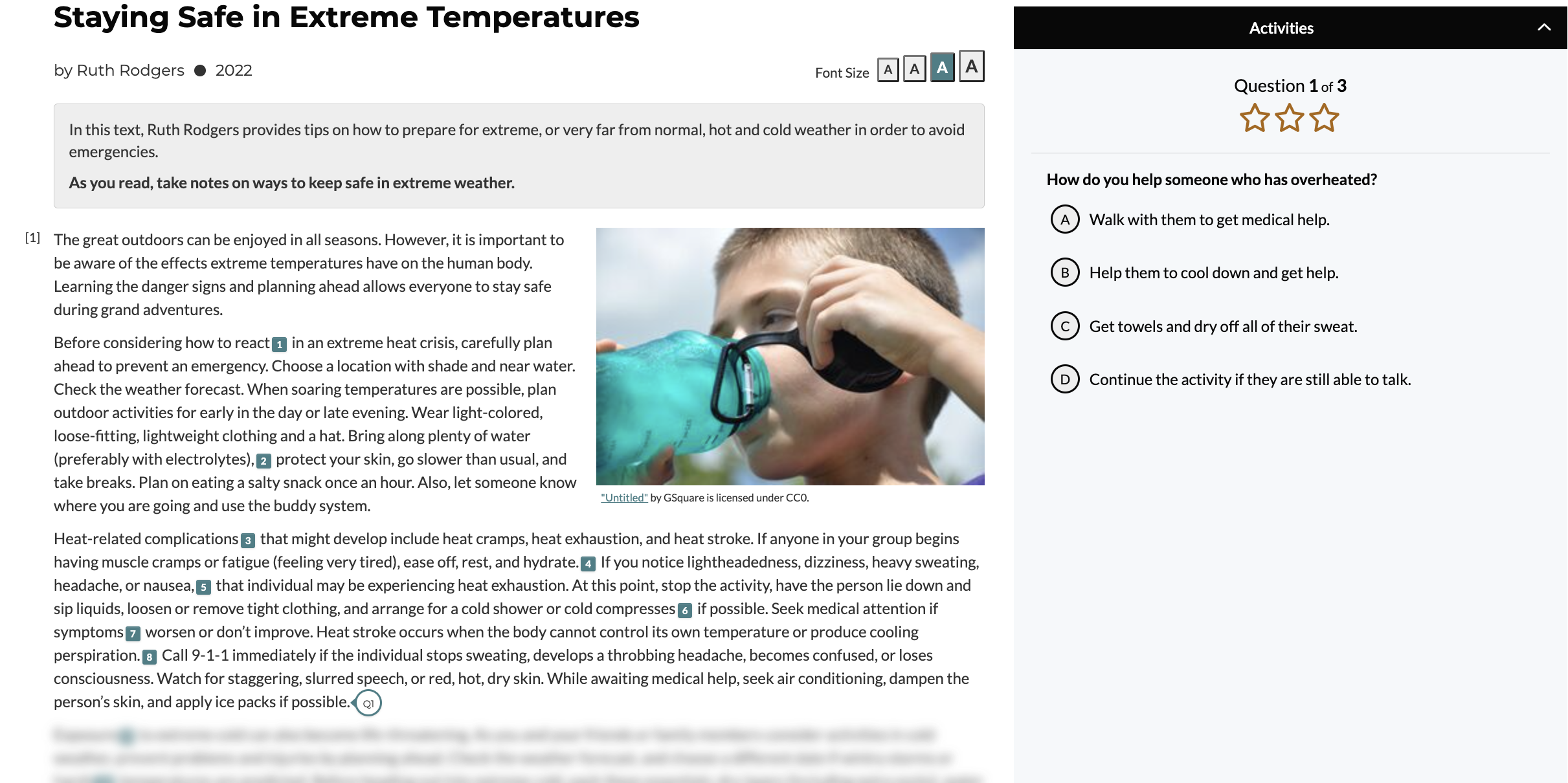Design a weather unit with 8 informational texts about weather for elementary students.
Teachers can access hundreds of informational texts to incorporate into their reading curriculum and broaden students’ knowledge about the world around them by using CommonLit’s digital literacy program.
In this blog post, we'll share 8 nonfiction texts about weather that will help students elevate their reading comprehension.
“Lightning Is No Joke!” by Jesse Sullivan (3rd Grade)
In this excerpt from Spectacular Stories for Curious Kids: A Fascinating Collection of True Stories to Inspire & Amaze Young Readers, Sullivan explains what happens when lightning strikes. The author shares a story about two hikers named Michael and Sean McQuilken, who are struck by lightning.
As students read, have them take notes on Michael and Sean’s story. Students can use their annotations to answer Assessment Question 5, “How does Michael and Sean McQuilken’s story support the main idea of the text?”
“They Need Fire!” by by Buffy Silverman (3rd grade)
This informational text explains how certain trees, insects, and birds rely on fire to grow and survive, a fact many might find surprising.
Show students the Related Media video “Are Fires Actually Good for Forests?” to provide them with additional information about how fires can be good for a forest. Ask students: What other types of trees need fire to release their seeds? Do you think the good parts of forest fires outweigh the bad? Why or why not?
“The World’s Weirdest Natural Disasters” by Marcia Amidon Lusted (4th grade)
Lusted describes the most unusual natural disasters that have harmed humans in various parts of the world.
Pair “The World’s Weirdest Natural Disasters” with “Don’t Fear the Bermuda Triangle” and have students think about how learning more about why things happen can help us feel less fearful. How does the author show readers that the Bermuda Triangle is a myth in “Don’t Fear the Bermuda Triangle”? How does the author of “The World’s Weirdest Natural Disasters” help the reader understand why these strange weather events have occurred?

“Hello! I’m An Earthquake” by Marcia Amidon Lusted (4th grade)
This non-fiction text describes how earthquakes develop. Told from the point of view of an earthquake itself, this text provides complex scientific information in a way that is engaging and fun!
Lead a classroom discussion with Discussion Question 4, “The author chose to teach this information from the point of view of an earthquake. Why do you think the author chose this point of view? How would this text be different if it was told from a different point of view, like that of a human who studies earthquakes or who has lived through an earthquake?”
“Tornado Chasing and Hurricane Hunting” by Marcia Amidon Lusted (5th grade)
In this article, the author explains how meteorologists and pilots play a significant role in understanding extreme weather storms.
As students read, have them take notes on how scientists collect information about tornadoes and hurricanes. Students can use their notes to provide supporting evidence in their answer to Assessment Question 5, “What is the biggest difference between storm chasing and hurricane hunting?”
“What Are Clouds” by NASA (5th grade)
This informational text explains how different types of clouds form and influence weather across Earth.
Show students the Related Media video “The Making of a Cloud” to help them better understand how clouds form and why it’s important for scientists to study them. Ask students to discuss any additional information provided in the video that was not mentioned in the text. What reasons does the video provide for paying attention to clouds?
“Staying Safe in Extreme Temperatures” by Ruth Rodgers (5th Grade)
In this informational text, Rodgers gives readers tips on surviving extreme weather conditions. Rodgers emphasizes that proper preparation can prevent injury and sickness in the most hazardous conditions.
Have students take notes on ways to keep safe in extreme weather. They can use their notes to answer Assessment Question 6, “How does the author support her claim that preparation can prevent disaster in extreme temperatures?” This question can help students understand the author’s point of view.

“The Ring of Fire” by Marcia Amidon Lusted (5th grade)
In this informational text, Lusted describes the natural disasters that occur on The Ring of Fire, a dangerous region known for its volcanoes, tsunamis, and earthquakes.
Show students the Related Media videos, which cover information about how volcanic eruptions, tsunamis, and earthquakes occur. Ask students to share how the videos furthered their understanding of how each type of natural disaster forms.
Next Steps
Looking for more texts about weather for elementary students? Check out our CommonLit library!
If your students need focused practice on finding the meaning of unknown words in a text, you can also check out our weather-related Target Lessons “They Need Fire!” and “The World's Weirdest Natural Disasters,” dedicated to vocabulary building. Target Lessons are a great way to add scaffolds and support differentiation in your ELA instruction.
If you’re interested in learning all about CommonLit’s free online reading program, join one of our upcoming webinars!


